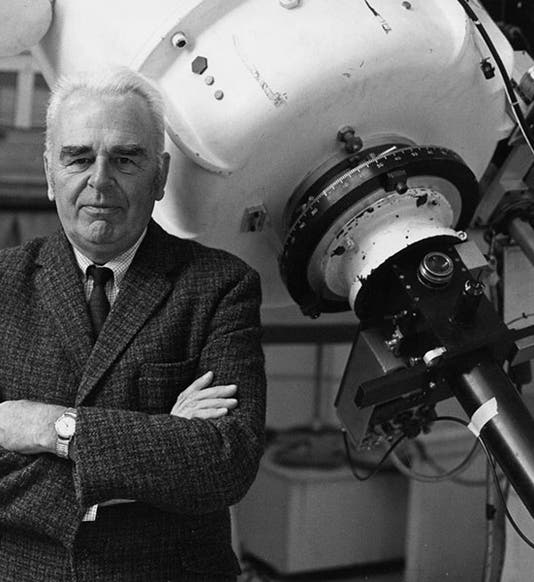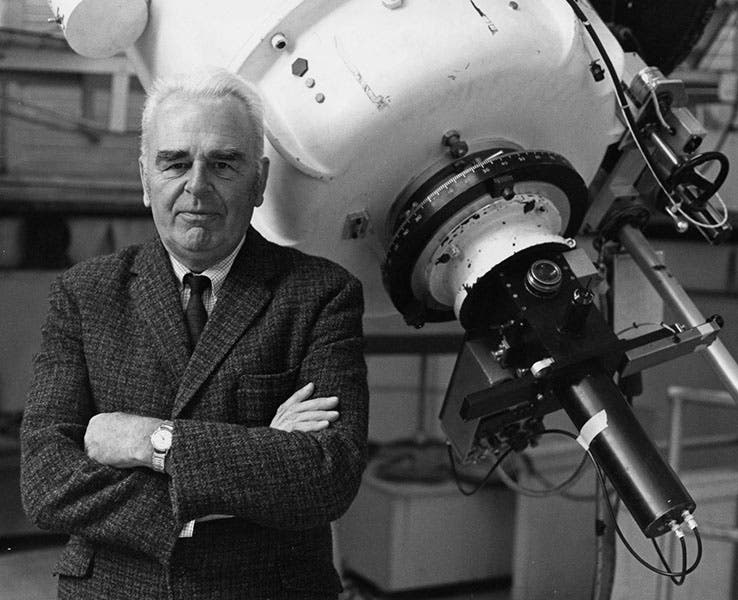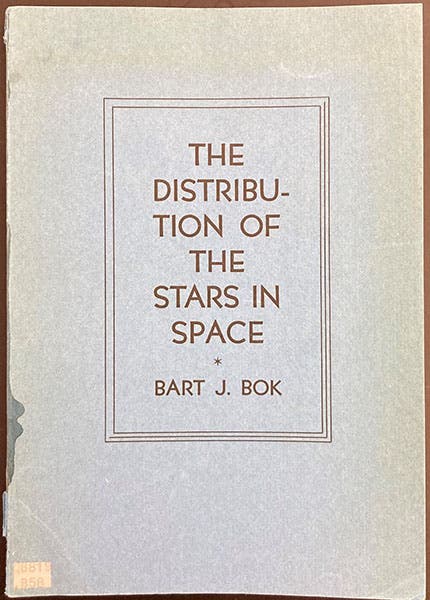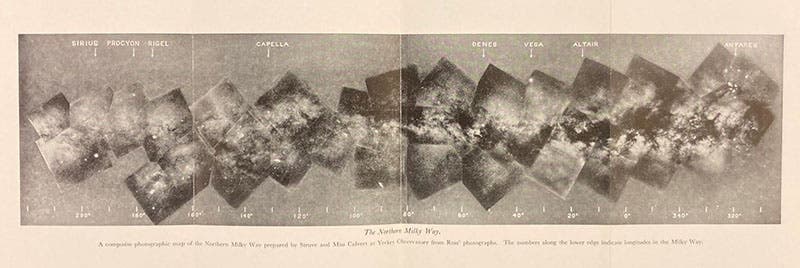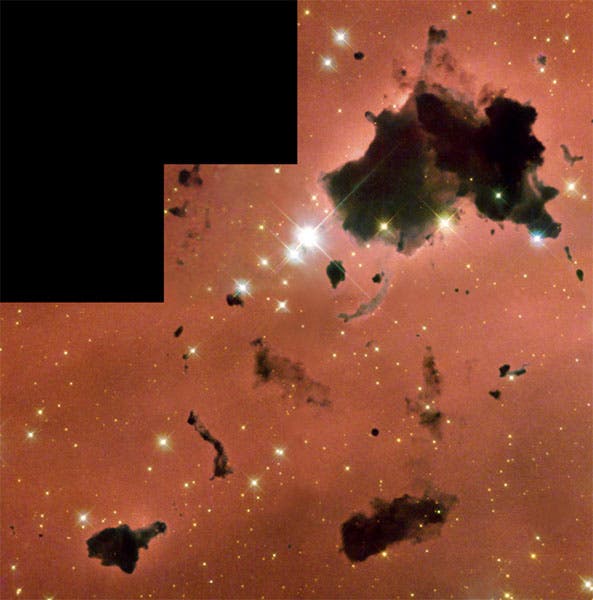Scientist of the Day - Bart Bok
Bartholomeus Jan "Bart" Bok , a Dutch-American astronomer, was born Apr. 28, 1906, in a town near Amsterdam in the Netherlands. He developed an interest in astronomy early in life, as most astronomers do, and studied at the universities of Leiden and Groningen. In 1928, the International Astronomical Union (IAU) met in Leiden, and Bok met both Priscilla Fairfield, an American associate professor of astronomy at Smith College, and Harlow Shapley, the dynamic young director of the Harvard College Observatory. Eighteen months later, Bok accepted Shapley's invitation to come to Harvard, and he married Priscilla, who was to be Bart's lifelong astronomical partner.
Shapley had stormed onto the astronomical landscape in 1918 with his study of globular clusters and his claim that they revealed the size and structure of the Milky Way galaxy, and the Earth’s place in that galaxy, and Bok followed pretty much the same path in the 1930s, trying to find ways to work out the details of the structure of the Milky Way, which was strongly suspected to be a spiral like the Andromeda galaxy. The problem was in trying to work out the location of the arms, from the vantage point of the Earth, which was almost certainly within one of those arms. He studied open star clusters, and galactic nebulae, and was one of the first to appreciate the potential of radio astronomy, when it was suggested as a possible new "ear" on the heavens in the 1930s. Radio telescopes would be used to finally confirm the Milky Way's spiral structure in 1952.
In 1937, Bok published his first book, The Distribution of the Stars in Space, which we have in the library, a fine copy still in its original paper cover (second image). This book is concerned with determining the extent of the absorption of light by dark nebulae and interstellar matter, so that intra-galactic distances could be more accurately measured. Shortly thereafter, Harlow Shapley launched a new Harvard-sponsored series of books on astronomy, and he asked Bart and Priscilla to write one on the Milky Way. They did so, although learning how to collaborate severely tested their marriage – they were both confident, strong-willed writers – but the result, The Milky Way, published in 1941, was a great success, and went through five editions in the next four decades (we have the editions of 1941, 1945, 1957, and 1981 in the Library). There were two long plates, mosaics of photos of the northern and southern Milky Way, folded up and stuck in a pocket at the end of the book, and I am sure readers enjoyed taking those out and spreading them open on a table; I certainly did. The Milky Way is a rather splendid sight when viewed that way (fifth image).
Bok and Priscilla spent some time setting up Harvard's Boyden Station in South Africa, which had been moved from Peru in search of better seeing, and where Bok was able to observe the great Carina nebula in the southern skies, and its star system, eta Carinae. Bok discovered many small dark regions in nebulae that were almost totally opaque. He called them "globules," noting their resemblance to the globules of fat that rise to the top of a bottle of unpasteurized milk. He hypothesized in 1947 that these globules are regions where gas and dust are being gravitationally contracted and in the process of forming stars. These were later named "Bok globules" (although Bok never used that name), and they are indeed now suspected to be the crucibles of star formation in nebulae. The Bok globule is probably Bok’s best-known acronym.
Bok was being groomed as the successor to Shapley as Director of the Harvard Observatory in the late 1940s, but unfortunately, Shapley, an outspoken men, fell afoul of Senator Joseph McCarthy and the House Committee on Un-American Activities in the early 1950s, and although Shapley was never fingered as a communist, the whole affair made James Conant, President of Harvard, very nervous, and he did not do as much as he should have to defend Shapley. Bok was never accused of anything, but he was clearly Shapley's man, so when Shapley finally retired in 1952, Bok was passed over for the directorship in favor of Donald Menzel. Bok was not happy about this, and although he stayed at Harvard for four more years, and succeeded in getting funding for and building Harvard’s first radio telescope, he ultimately left Harvard in 1956, accepting an offer to take over the Mount Stromlo Observatory near Canberra, Australia, which he did enthusiastically, becoming a well-known and widely appreciated national figure in Australia for almost 10 years. He was especially active with the launch of Sputnik in October 1957, seeing the event as an opportunity to educate the public about astronomy and space flight.
Bok returned to the U.S. in 1966, to become the head of the Steward Observatory in Tucson, Arizona, where he lived out the rest of his life. He retired from observatory life in 1970 and returned to creating public awareness about astronomy, which had always been a strong interest, but now he pursued it full time. In particular, he mustered fellow astronomers to campaign against astrology, then as now a very active pseudoscience, and Bok never took well to pseudo anything. His life took a downturn when Priscilla had a stroke in 1972 and slid into dementia, finally passing away in 1975. Bok resigned all his remaining official positions and cared for Priscilla full-time. Priscilla had always been fond of the aviary at the Arizona Sonora Desert Museum not far from Tucson, and she had complained that they had no place to sit down, once you got there. As a memorial, Bart commissioned a bench in her honor and had it installed in the aviary, so you could be entertained by the hummingbirds and be comfortable at the same time. There is no better and more useful memorial than a bench, in my opinion. When I first posted this, I lamented that I could find no photo of the Priscilla Bok memorial bench. David Levy has now sent me two photos, taken by his friend David Rossetter, and I am happy to include them as the last two images in this revised post.
Bok did not live to see the launching of the Hubble Space Telescope (HST) in 1990, and its recent successor, the James Webb Space Telescope, so he never had the pleasure of seeing what his Bok globules look like in high resolution and living color. The image of nebula IC 2944 (sixth image) was taken by the HST and released in 2002, and is now a textbook photo for Bok globules (even though these particular globules are often called Thackeray globules, after the astronomer who first spotted them). Five years later, the HST released a series of images of the Carina nebula that attracted so much of Bok's professional attention; if you can tear your eyes from the one-million-light-year-long "finger" of gas and dust at the left, you can see a splendid Bok "tadpole" at the far right, in front of the star cluster Trumpler 14 (seventh image).
Much of what I know about Bart Bok I gleaned from one book: The Man Who Sold the Milky Way: A Biography of Bart Bok, by David H. Levy (1993). It is written at just the right level, accessible and full of stories for the general reader, and yet informative and reliable for the professional historian or astronomer. I really enjoyed reading it. Dr. Levy did hundreds of hours of oral interviews with Bok in preparation for writing his biography; those tapes are on deposit at the Linda Hall Library, along with Dr. Levy’s professional observation logs and records.
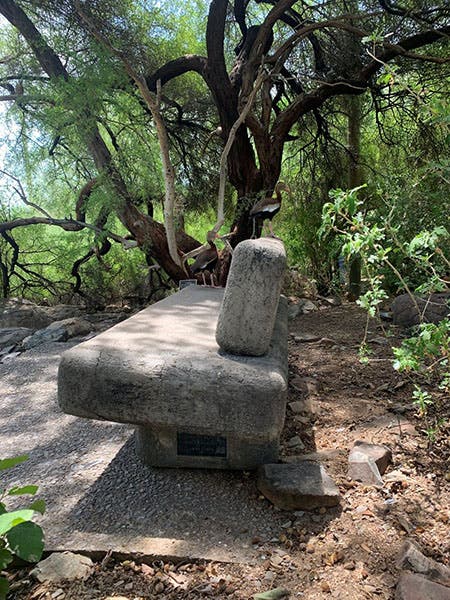
The Priscilla Bok Memorial Bench, in the aviary at the Arizona Sonoma Desert Museum, Tucson (photo by David Rossetter, courtesy of David Levy)

The plaque on the Priscilla Bok Memorial Bench, in the aviary at the Arizona Sonoma Desert Museum, Tucson (photo by David Rossetter, courtesy of David Levy)
This post was revised on May 5, 2023, so that the two photographs of the Priscilla Bok memorial bench could be added.
William B. Ashworth, Jr., Consultant for the History of Science, Linda Hall Library and Associate Professor emeritus, Department of History, University of Missouri-Kansas City. Comments or corrections are welcome; please direct to ashworthw@umkc.edu.

